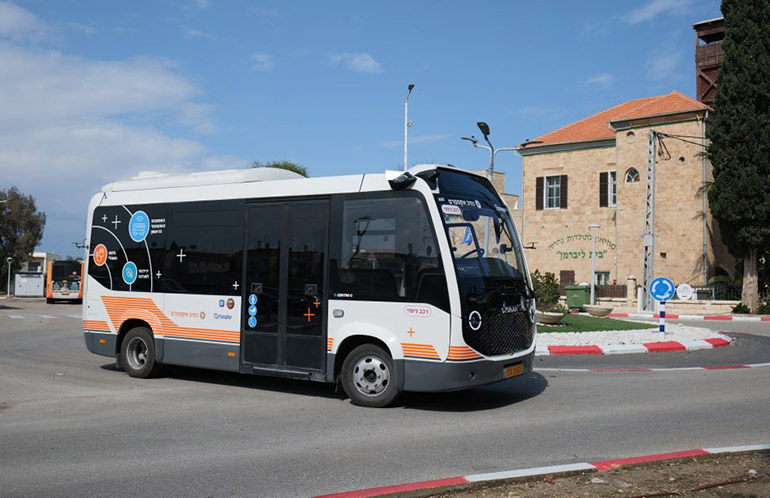Eugene Demaitre
2024-11-25 14:18:00
www.therobotreport.com
|
Listen to this article |

Imagry says its software enables buses to autonomously handle complex situations such as roundabouts. Source: Imagry
Autonomous vehicles often rely heavily on prior information about their routes, but new technology promises to improve real-time situational awareness for vehicles including buses. Imagry said its “HD-mapless driving” software stack enables vehicles to react to dynamic contexts and situations more like human drivers.
The company also said its AI Vision 360 eliminates the need for external sensor infrastructure. It claimed that its bio-inspired neural network and hardware-agnostic systems allow for SAE Level 3/4 operations without spending time on mapping.
“We’ve been focusing on two sectors,” said Eran Ofir, CEO of Imagry. “We’ve been selling our perception and motion-planning stack to Tier 1 suppliers and automotive OEMs for autonomous vehicles. We signed a 10-year contract with Continental and are jointly developing a software-defined vehicle platform.”
“And we’ve started working with transportation operators on providing autonomous buses,” he told The Robot Report. “For example, in Turkey, France, Spain, and soon Japan, we’re retrofitting electric buses to be autonomous.”
Imagry trains in real time with supervision
Ofir started Imagry in 2015 with a focus on computer vision for retail and pivoted to autonomous driving in 2018. The company now has about 120 employees in San Jose, Calif., and Haifa, Israel.
Imagry said its technology is similar to that of Tesla in relying on 3D vision for perception and motion planning rather than rule-based coding or maps.
“Most players in the industry use HD maps with 5 cm [1.9 in.] resolution, telling the vehicle where lights, signs, and lane markers are,” said Ofir. “Our system teaches itself with supervised learning. It maps in real time while driving. Like a human driver, it gets the route but doesn’t know what it will find.”
How does Imagry deal with the need for massive data sets to train for navigation and obstacle detection and avoidance?
“We wrote a proprietary tool for annotation to train faster, better, and cheaper,” Ofir replied. “The data is collected but doesn’t live in the cloud. The human supervisor tells the vehicle where it was wrong, like a child. We deliver over-the-air updates to customers.”
“The world doesn’t belong to HD maps — it’s a matter of trusting AI-based software for perception and motion planning,” he said.
Ofir cited an example of a vehicle in Arizona on a random route with no communications to centralized computing. Its onboard sensors and compute recognized construction zones, skateboarders, a bike lane, and stop signs.
“The capability to drive out of the box in new places is unique to Imagry,” asserted Ofir. “We can handle righthand and lefthand driving, such as in Tokyo, where we’ve been driving for a year now.”
How does the bus know when to stop for passengers?
It could stop at every bus stop, upon request via a button at the stop (for the elderly, who may not use phone apps), or be summoned by an app that also handles payment, responded Ofir. Imagry’s system also supports “kneeling” for people with disabilities.
Why buses are a better focus for autonomy
Imagry has decided to focus on urban use cases rather than highways. Buses are simpler to get to Level 4 autonomy, said Ofir.
“Autonomous buses are better than ride hailing; they’re simpler than passenger vehicles,” said Ofir. “They drive in specific routes and at a speed of only 50 kph [31 mph] versus 80 kph [50 mph]. It’s a simpler use case, with economies of scale.”
“The time to revenue is much faster — the design cycle is four years, while integrating with a bus takes two to three months,” he explained. “Once we hand it over to the transport operator, we can get to L4 in 18 months, and then they can buy and deploy 40 more buses.”
In addition, the regulations for autonomous buses are clearer, with 22 countries running pilots, he noted.
“We already have projects with a large medical center and on a public road in Israel,” Ofir said. “We’re not doing small pods — most transport operators desire M3-class standard buses for 30 to 45 passengers because of the total cost of ownership, and they know how to operate them.”
In September and October, Imagry submitted bids for autonomous buses in Austria, Portugal, Germany, Sweden, and Japan.
Software focus could save money
By being vehicle-agnostic, Ofir said Imagry avoids being tied to specific, expensive hardware. Fifteen vendors are making systems on chips (SoCs) that are sufficient for Level 3 autonomy, he said.
“OEMs want the agility to use different sets of hardware in different vehicles. A $30,000 car is different from a $60,000 car, with different hardware stacks and bills of materials, such as camera or compute,” said Ofir. “It’s a crowded market, and the autonomy stack still costs $100,000 per vehicle. Ours is only $3,000 and runs on Ambarella, NVIDIA, TI, Qualcomm, and Intel.”
“With our first commercial proof of concept for Continental in Frankfurt, Germany, we calibrated our car and did some localization,” he added. “Three days after arrival, we simply took it out on the road, and it drove, knowing there’s no right on red.”
With shortages of drivers, particularly in Japan, operators could save $40,000 to $70,000 per bus per year, he said. The Japanese government wants 50 locations across the country to be served with autonomous buses by 2025 and 100 by 2027.
Autonomous buses are also reliable around the clock and don’t get sick or go on strike, he said.
“We’re working on fully autonomous parking, traffic jam assist, and Safe Driver Overwatch to help younger or older drivers obey traffic signs, which could be a game-changer in the insurance industry,” he added. “Our buses can handle roundabouts, narrow streets, and mixed traffic and are location-independent.”
Phases of autonomous bus deployment
Technology hurdles aside, getting autonomous buses recognized by the rules of the road requires patience, said Ophir.
“I wrote the bill for Mobileye for robotaxis with the Israeli government,” recalled Ofir. “We’re working with lawmakers in France and Germany and will launch pilots in three markets in 2025.”
Testing even Level 3 autonomy can take years, depending on the region. He outlined the phases for autonomous bus rollout:
- Work with the electric bus for that market, then activate the system on a public road. “In the U.S., we’ve installed the full software and control stack in a vehicle and are testing FSD [full self-driving],” Ofir said.
- Pass NCAP (European New Car Assessment Programme) testing for merging and stops in 29 scenarios. “We’re the only company to date to pass those tests,” said Ofir. “Japan also has stringent safety standards.”
- Pass the cybersecurity framework in Europe; then be allowed onboard buses with a safety driver.
- Autonomously drive 100,000 km (62,137 mi.) on a designated route for 18 to 24 months. After submitting a report to a department of motor vehicles or the equivalent, Imagry could then remove the human driver.
“The silicon, sensors, and software don’t matter for time to revenue, and getting approvals from the U.S. National Highway Traffic Safety Administration [NHTSA] can take years,” Ofir said. “We expect passenger vehicles with our software on the road in Europe, the U.S., and Japan sometime in 2027.”
Imagry has joined Partners for Automated Vehicle Education (PAVE) and will be exhibiting at CES in January 2025.

Keep track of your essentials with the Apple AirTag 4 Pack, the ultimate tracking solution for your belongings. With over 5,972 ratings and a stellar 4.7-star average, this product has quickly become a customer favorite. Over 10,000 units were purchased in the past month, solidifying its status as a highly rated Amazon Choice product.
For just $79.98, you can enjoy peace of mind knowing your items are always within reach. Order now for only $79.98 at Amazon!
Source Link
Support Techcratic
If you find value in Techcratic’s insights and articles, consider supporting us with Bitcoin. Your support helps me, as a solo operator, continue delivering high-quality content while managing all the technical aspects, from server maintenance to blog writing, future updates, and improvements. Support Innovation! Thank you.
Bitcoin Address:
bc1qlszw7elx2qahjwvaryh0tkgg8y68enw30gpvge
Please verify this address before sending funds.
Bitcoin QR Code
Simply scan the QR code below to support Techcratic.

Please read the Privacy and Security Disclaimer on how Techcratic handles your support.
Disclaimer: As an Amazon Associate, Techcratic may earn from qualifying purchases.




































































































